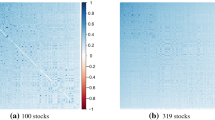Abstract
This study aims to reduce the statistical uncertainty of the correlation coefficient matrix in the mean-variance model of Markowitz. A filtering algorithm based on minimum spanning tree (MST) is proposed. Daily data of the 30 stocks of the Hang Seng Index (HSI) and Dow Jones Index (DJI) from 2004 to 2009 are selected as the base dataset. The proposed algorithm is compared with the Markowitz method in terms of risk, reliability, and effective size of the portfolio. Results show that (1) although the predicted risk of portfolio built with the MST is slightly higher than that of Markowitz, the realized risk of MST filtering algorithm is much smaller; and (2) the reliability and the effective size of filtering algorithm based on MST is apparently better than that of the Markowitz portfolio. Therefore, conclusion is that filtering algorithm based on MST improves the mean-variance model of Markowitz.
Similar content being viewed by others
References
Basalto, N., Bellotti, R., De Carlo, F., Facchi, P. & Pascazio, S. (2005). Clustering stock market companies via chaotic map synchronization. Physica A. Statistical Mechanics and its Applications, 345(1–2): 196–206
Bouchaud, J.P. & Potters, M. (2003). Theory of Financial Risk and Derivative Pricing. Cambridge University Press, London
Eom, C., Oh, G., Jung, W.-S., Jeong, H. & Kim, S. (2009). Topological properties of stock networks based on minimal spanning tree and random matrix theory in financial time series. Physica A: Statistical Mechanics and its Applications, 388(6): 900–906
Eom, C., Kwon, O., Jung, W.-S. & Kim, S. (2010).The effect of a market factor on information flow between stocks using the minimal spanning tree. Physica A: Statistical Mechanics and its Applications, 389(8): 1643–1652
Gilmore, C.G., Lucey, B.M. & Boscia, M. (2008). An ever-closer union? Examining the evolution of linkages of European equity markets via minimum spanning trees. Physica A: Statistical Mechanics and its Applications, 387(25): 6319–6329
Huang, F.X., Zhao, X. & Hou, T.S. (2009). Index hierarchical structure of Shanghai 50 Stock based on minimum spanning tree. Systems Engineering, 27(1): 71–76
Jiang, Y.P., Fan, Z.P. & Li, B. (2006). Cluster analysis based on mixed attribute information. Systems Engineering, 24(10): 6–10
Plerou, V., Gopikrishnan, P., Rosenow, B., Amaral, L.A., Guhr, T. & Stanley, H.E. (2002). Random matrix approach to cross correlations in financial data. Physical Review E, 65(6): 066126
Kellerer, H., Mansini, R. & Speranza, M.G. (2000). On selecting a portfolio with fixed costs and minimum lots. Annals of Operations Research, 99(3): 287–304
Kruskal, B.Jr. (1956). On the shortest spanning subtree of a graph and the traveling salesman problem. Proceedings of the American Mathematical Society, 7(1): 48–50
Mantegna, R.N. (1999). Hierarchical structure in financial markets. The European Physical Journal B — Condensed Matter and Complex Systems, 11(1): 193–197
Markowitz, H.M. (1952). Portfolio selection. Journal of Finance, 7(1): 77–91
Markowitz, H.M. (1991). Foundations of portfolio theory. Journal of Finance, 46(2): 469–477
Di Matteo, T., Aste, T. & Mantegna, R.N. (2004). An interest rates cluster analysis. Physica A: Statistical Mechanics and its Applications, 339(1–2): 181–188
Pafka, S. & Kondor, I. (2002). Noisy covariance matrices and portfolio optimization. The European Physical Journal B — Condensed Matter and Complex Systems, 27(2): 277–280
Pafka, S. & Kondor, I. (2003). Noisy covariance matrices and portfolio optimization II. Physica A: Statistical Mechanics and its Applications, 319(1): 487–494
Rockafellar, R.T. & Uryasev, S. (2000). Optimization of conditional value-at-risk. Journal of Risk, 2(3): 21–41
Rosenow, B., Gopikrishnan, P., Plerou, V. & Stanley, H.E. (2002). Random magnets and correlations of stock price fluctuations. Physica A: Statistical Mechanics and its Applications, 314(1–4): 762–767
Sharpe, W.F. (1964). Capital asset prices: a theory of market equilibrium under conditions of risk. Journal of Finance, 19(3): 425–442
Tu, X.S. & Wang, J. (1999). A few advances in modern invest selection theory. Systems Engineering, 17(1): 58–62
Tumminello, M., Lillo, F. & Mantegna, R.N. (2007). Hierarchically nested factor model from multivariate data. Europhysics Letters (EPL), 78(3): 30006
Author information
Authors and Affiliations
Corresponding authors
Additional information
This work is supported by the funds project under the Ministry of Education of the PRC for young people who are devoted to the researches of humanities and social sciences under Grant No. 09YJC790025.
Feixue Huang graduated from Dalian University of Technology of China and is an Associate Professor in the School of Economics at Dalian University of Technology of China. His research interests include system complexity and financial engineering.
Lei Sun got Master degree in 2010 from Economics School, Faculty of Management and Economics, Dalian University of Technology, Dalian China. Her main research interests are portfolio optimization of markowitz and statistical method.
Yun Wang is a master student in Economics School, Faculty of Management and Economics, Dalian University of Technology, China. She will graduate in 2012. Her major is international economics. Her research interests are primary commodities and exchange rates.
Rights and permissions
About this article
Cite this article
Huang, F., Sun, L. & Wang, Y. Mean-variance model based on filters of minimum spanning tree. J. Syst. Sci. Syst. Eng. 20, 495–506 (2011). https://doi.org/10.1007/s11518-011-5178-6
Published:
Issue Date:
DOI: https://doi.org/10.1007/s11518-011-5178-6



